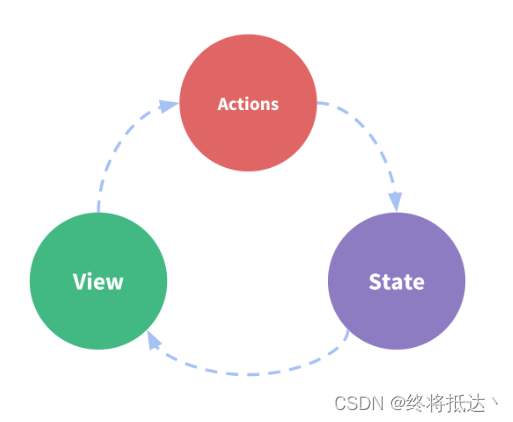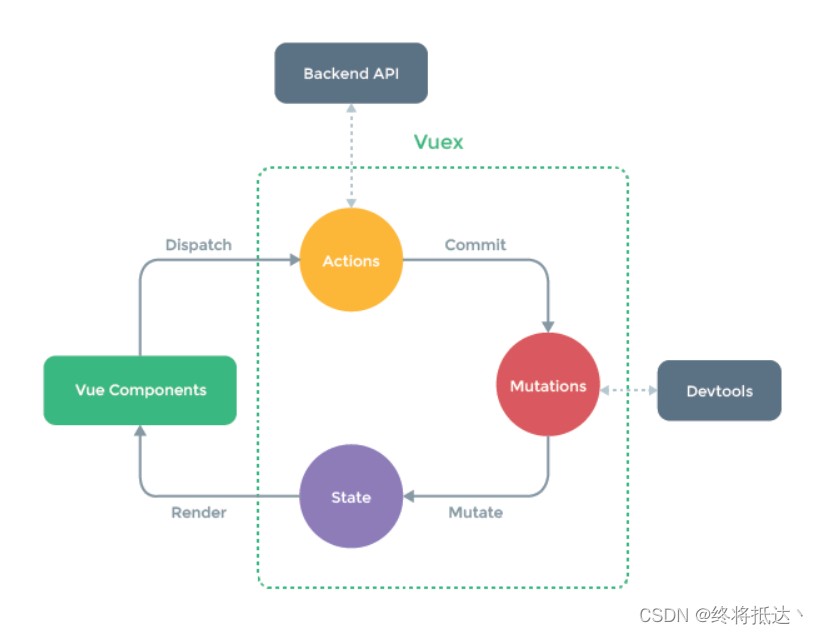一、VueX是什么
Vuex 是一个专为 Vue.js 应用程序开发的状态管理模式 + 库。它采用集中式存储管理应用的所有组件的状态,并以相应的规则保证状态以一种可预测的方式发生变化。
二、为什么要用VueX
“单向数据流”理念的简单示意:

当我们的应用遇到多个组件共享状态时,单向数据流的简洁性很容易被破坏:
- 多个视图依赖于同一状态。
- 来自不同视图的行为需要变更同一状态。
对于问题一,传参的方法对于多层嵌套的组件将会非常繁琐,并且对于兄弟组件间的状态传递无能为力。对于问题二,我们经常会采用父子组件直接引用或者通过事件来变更和同步状态的多份拷贝。以上的这些模式非常脆弱,通常会导致无法维护的代码。
因此,我们为什么不把组件的共享状态抽取出来,以一个全局单例模式管理呢?在这种模式下,我们的组件树构成了一个巨大的“视图”,不管在树的哪个位置,任何组件都能获取状态或者触发行为!
通过定义和隔离状态管理中的各种概念并通过强制规则维持视图和状态间的独立性,我们的代码将会变得更结构化且易维护。
VueX由此诞生:

三、VueX的五大模块
(一)State:单一状态树
Vuex 使用单一状态树——是的,用一个对象就包含了全部的应用层级状态。至此它便作为一个“唯一数据源 (SSOT)”而存在。这也意味着,每个应用将仅仅包含一个 store 实例。单一状态树让我们能够直接地定位任一特定的状态片段,在调试的过程中也能轻易地取得整个当前应用状态的快照。
简单来说就是该项目中的所有状态都放在State中。
import Vue from 'vue'
import Vuex from 'vuex'
Vue.use(Vuex)
export default new Vuex.Store({
state: {
// 全局个人数据
userInfo:{},
isLogin:true,
loading:false,
tabActive:0
},
mutations: {
},
actions: {
},
modules: {
}
})
在别的页面使用时的获取方式
1.直接从store实例取值
main.js中,把store注册在根实例下
import store from './store' (1)在其他页面js中可使用this.$stroe.state.属性直接取值
export default {
computed: {
testNum() {
return this.$store.state.testNum;
}
}
};(2)在其他页面的html中书写为$stroe.state.属性
<div class="box" v-id="$store.state.isLogin">
<MySelfHeader></MySelfHeader>
<MySelfBody></MySelfBody>
</div>2.mapState 辅助函数
当一个组件需要获取多个状态的时候,将这些状态都声明为计算属性会有些重复和冗余。为了解决这个问题,我们可以使用 mapState 辅助函数帮助我们生成计算属性.
先引入 import {mapState} from "vuex";
// 在单独构建的版本中辅助函数为 Vuex.mapState
import { mapState } from 'vuex'
export default {
// ...
computed: mapState({
// 箭头函数可使代码更简练
count: state => state.count,
// 传字符串参数 'count' 等同于 `state => state.count`
countAlias: 'count',
// 为了能够使用 `this` 获取局部状态,必须使用常规函数
countPlusLocalState (state) {
return state.count + this.localCount
}
})
} 当映射的计算属性的名称与 state 的子节点名称相同时,我们也可以给 mapState 传一个字符串数组。
computed: mapState([
// 映射 this.count 为 store.state.count
'count'
])(二)Getter
有时候我们需要从 store 中的 state 中派生出一些状态,例如对列表进行过滤并计数:
computed: {
doneTodosCount () {
return this.$store.state.todos.filter(todo => todo.done).length
}
}Vuex 允许我们在 store 中定义“getter”(可以认为是 store 的计算属性)。
Getter 接受 state 作为其第一个参数:
const store = createStore({
state: {
todos: [
{ id: 1, text: '...', done: true },
{ id: 2, text: '...', done: false }
]
},
getters: {
doneTodos (state) {
return state.todos.filter(todo => todo.done)
}
}
})在别的页面的获取方式:
Js中:this.$store.getters.方法/属性
html中:$store.getters.方法/属性
(三)Mutation
更改 Vuex 的 store 中的状态的唯一方法是提交 mutation。Vuex 中的 mutation 非常类似于事件:每个 mutation 都有一个字符串的事件类型 (type)和一个回调函数 (handler)。这个回调函数就是我们实际进行状态更改的地方,并且它会接受 state 作为第一个参数:
const store = createStore({
state: {
count: 1
},
mutations: {
increment (state) {
// 变更状态
state.count++
}
}
}) 你不能直接调用一个 mutation 处理函数。这个选项更像是事件注册:“当触发一个类型为 increment 的 mutation 时,调用此函数。”要唤醒一个 mutation 处理函数,你需要以相应的 type 调用 store.commit 方法:
store.commit('increment')提交载荷(Payload)
你可以向 store.commit 传入额外的参数,即 mutation 的载荷(payload):
mutations: {
increment (state, payload) {
state.count += payload.amount
}
}store.commit('increment', {
amount: 10
})注意:Mutation 必须是同步函数,不能再Mutation中进行异步操作
***在组件中提交 Mutation***
你可以在组件中使用 this.$store.commit('xxx') 提交 mutation,或者使用 mapMutations 辅助函数将组件中的 methods 映射为 store.commit 调用(需要在根节点注入 store)。
import { mapMutations } from 'vuex'
export default {
// ...
methods: {
...mapMutations([
'increment', // 将 `this.increment()` 映射为 `this.$store.commit('increment')`
// `mapMutations` 也支持载荷:
'incrementBy' // 将 `this.incrementBy(amount)` 映射为 `this.$store.commit('incrementBy', amount)`
]),
...mapMutations({
add: 'increment' // 将 `this.add()` 映射为 `this.$store.commit('increment')`
})
}
}重点:Mutation中的方法要通过commit来调用
(四)Action
某些情况我们希望在vuex中进行一些异步操作,比如网络请求,必然是异步的,那这个时候就需要用actions了。
Action 类似于 mutation,不同在于:
- Action 提交的是 mutation,而不是直接变更状态。
- Action 可以包含任意异步操作。
const store = createStore({
state: {
count: 0
},
mutations: {
increment (state) {
state.count++
}
},
actions: {
increment (context) {
context.commit('increment')
}
}
}) Action 函数接受一个与 store 实例具有相同方法和属性的 context 对象,因此你可以调用 context.commit 提交一个 mutation,或者通过 context.state 和 context.getters 来获取 state 和 getters。
分发 Action
Action 通过 store.dispatch 方法触发:
store.dispatch('increment')乍一眼看上去感觉多此一举,我们直接分发 mutation 岂不更方便?实际上并非如此,还记得 mutation 必须同步执行这个限制么?Action 就不受约束!我们可以在 action 内部执行异步操作:
actions: {
incrementAsync ({ commit }) {
setTimeout(() => {
commit('increment')
}, 1000)
}
}Actions 支持同样的载荷方式和对象方式进行分发:
// 以载荷形式分发
store.dispatch('incrementAsync', {
amount: 10
})
// 以对象形式分发
store.dispatch({
type: 'incrementAsync',
amount: 10
})****在组件中分发 Action***
你在组件中使用 this.$store.dispatch('xxx') 分发 action,或者使用 mapActions 辅助函数将组件的 methods 映射为 store.dispatch 调用(需要先在根节点注入 store):
import { mapActions } from 'vuex'
export default {
// ...
methods: {
...mapActions([
'increment', // 将 `this.increment()` 映射为 `this.$store.dispatch('increment')`
// `mapActions` 也支持载荷:
'incrementBy' // 将 `this.incrementBy(amount)` 映射为 `this.$store.dispatch('incrementBy', amount)`
]),
...mapActions({
add: 'increment' // 将 `this.add()` 映射为 `this.$store.dispatch('increment')`
})
}
}(五)Module
由于使用单一状态树,应用的所有状态会集中到一个比较大的对象。当应用变得非常复杂时,store 对象就有可能变得相当臃肿。
为了解决以上问题,Vuex 允许我们将 store 分割成模块(module)。每个模块拥有自己的 state、mutation、action、getter、甚至是嵌套子模块——从上至下进行同样方式的分割:
const moduleA = {
state: () => ({ ... }),
mutations: { ... },
actions: { ... },
getters: { ... }
}
const moduleB = {
state: () => ({ ... }),
mutations: { ... },
actions: { ... }
}
const store = createStore({
modules: {
a: moduleA,
b: moduleB
}
})
store.state.a // -> moduleA 的状态
store.state.b // -> moduleB 的状态四、VueX的源码
let Vue;
//定义一个Store类
class Store {
constructor () {
this._vm = new Vue({
data: {
$$state: this.state
}
})
}
commit (type, payload, _options) {
const entry = this._mutations[type];
entry.forEach(function commitIterator (handler) {
handler(payload);
});
}
dispatch (type, payload) {
const entry = this._actions[type];
return entry.length > 1
? Promise.all(entry.map(handler => handler(payload)))
: entry[0](payload);
}
}
//保证 vm 中都可以访问 store 对象
function vuexInit () {
const options = this.$options;
if (options.store) {
this.$store = options.store;
} else {
this.$store = options.parent.$store;
}
}
//Vue.js 提供了一个 Vue.use 的方法来安装插件,内部会调用插件提供的 install 方法。所以我们的插件需要提供一个 install 方法来安装。
export default install (_Vue) {
Vue.mixin({ beforeCreate: vuexInit });
Vue = _Vue;
}更多详情请跳转官网——